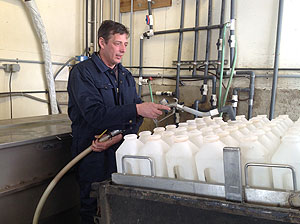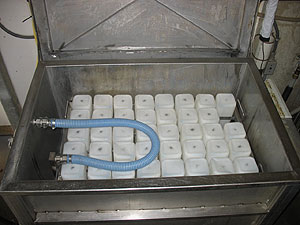Healthy Calf Conference
Follow to stay up-to-date on all Healthy Calf Conference updates. Speaker announcements, sponsorship information, registration announcements, and more.
Keeping calves free of disease and getting them off to a good start in life is a top priority for dairy farmers Henry and Rose Keunen of Strathroy.
They’ve won a Premier’s Award for Agri-Food Innovation Excellence for an integrated milk pasteurizer and calf bottle washer system designed by Henry. Not only does his invention save a lot of labour, it is also contributing significantly to better calf health, including less diarrhea and elimination of Johne’s Disease transmission.

The Keunens used to feed the calves by hand and rinse their calf bottles daily with warm water, disinfecting them with chlorine water only when they showed signs of residue. However, bottles are a perfect environment for growing pathogens like e.coli, bovine viral diarrhea virus, salmonella and others.
Rose Keunen says she and her husband searched the world for a milk pasteurizing system that was also able to wash and disinfect milk bottles, and finding none, Henry set out to design his own.
They purchased a Westwaard pasteurizer from Dairy Lane Systems in Ilderton and built a bottle washer that fits perfectly inside the pasteurizer and uses its wash system to rinse, wash and disinfect the bottles for each use. It’s been so successful that Dairy Lane now manufactures the bottle washer, making it available to other farmers along with the pasteurizer.

“It’s very simple to fill the bottles with milk. The bottles are put on a rack for filling and when they are empty, they go back on the same rack but upside down, and into the pasteurizer for washing,” she explains. “The bottles are disinfected before every feeding and all the nipples go in a pail with chlorine water before they go on the bottle. You can scratch the clean bottles with your nail and you will see no residue. If you only rinse a bottle with hot water, it is still dirty and the film layer will cause bacteria to grow, which you are then feeding to your calves.”
At night the Keunens fill their pasteurizer with the amount of milk they need for their morning and lunch time feedings. In the morning, a timer turns on the pasteurizer and the milk is cooled to a preset temperature. The milk is always at a perfect 38C feeding temperature when the bottle is put in the holder in front of the calf.
“The timer makes it flexible to work for everybody and you don’t have to be a slave to your milking schedule,” says Rose. “At lunch we will heat the milk back up to the right temperature before filling the bottles. We always make sure the milk is at the right temperature because warm milk for calves is very important.”
The Keunens are proud of their extremely low calf mortality rate of only about two per cent from birth to age two years. Rose says they’ve always been very particular about the milk they use for their calves, never using any from cows that have or had mastitis or diarrhea or other health problems, and once they started pasteurizing milk and disinfecting their bottles, they noticed the number of diarrhea cases in calves decreasing even more.
“We didn’t expect the diarrhea in the calves to decrease even more, so that was just a bonus,” she says. “We also are not having any positive Johne’s tests as you can’t transfer the bacteria through pasteurized milk.”
The Keunens pay close attention to record-keeping and have developed their own simple print sheets they use for daily monitoring of calf performance. During their three times daily feedings, they keep track of how many calves they have on colostrum and regular milk, how much each calf consumes and which calves still need help getting to the bottle holder.
During feeding, they walk among the hutches observing the animals. If they notice anything abnormal, such as not finishing a whole bottle of milk, playing with the nipple instead of drinking or lying down at feeding time, it is recorded and the calf is immediately started on electrolytes.
“We want to catch them before they get sick. If they go off the bottle they might still feel fine but something is already a bit off in the biological system,” she explains, adding that anyone entering a hutch does so with hands washed in chlorine water and clean boots. “If we catch them on day one off the bottle and quickly get them on electrolytes, nine out of ten don’t get diarrhea. And if they get it, they get it lightly.”
They have fully written protocols for everything and their record-keeping system works really well, Rose adds, explaining that everybody knows exactly what needs to be done even if they’re not working with the calves on a daily basis.
“We have simplified the system so everybody can do it and it works really well. There is no chance for miscommunication or forgetting to let the next staff know if you use the chart,” says Rose. “Everybody is trained this way and it works absolutely wonderfully.”
Follow to stay up-to-date on all Healthy Calf Conference updates. Speaker announcements, sponsorship information, registration announcements, and more.
The Codes of Practice are nationally developed guidelines for the care and handling of farm animals. They serve as our national understanding of animal care requirements and recommended practices.